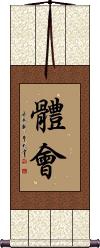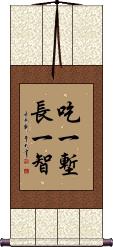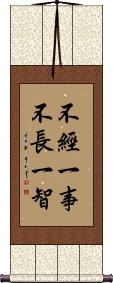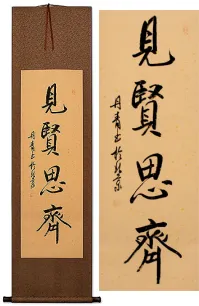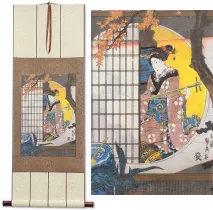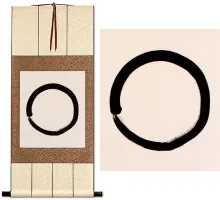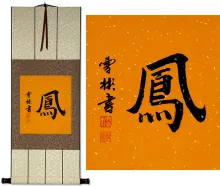Many custom options...
And formats...

Not what you want?
Try other similar-meaning words, fewer words, or just one word.
Knowledge From Experience in Chinese / Japanese...
Buy a Knowledge From Experience calligraphy wall scroll here!
Personalize your custom “Knowledge From Experience” project by clicking the button next to your favorite “Knowledge From Experience” title below...
Knowledge from Experience
Each Time You Stumble and Fall, You Gain Experience and Wisdom
吃一塹長一智 is a Chinese proverb that means “Fall into a moat, and you will gain wisdom from the experience.”
It really suggests that the failures, troubles, frustrations, and setbacks that you encounter in your life are actually helping you to find wisdom. Some would also translate this proverb as “Learn from your mistakes” or “Learn from your experience.”
If you are studying Chinese, you will recognize the first character as “eat,” but in this case, it means to “experience” (as used in this proverb, it is suggesting that you have fallen into a moat and/or had a hard time crossing it).
Translated character by character, this whole proverb is, “Experience one moat, gain one wisdom/knowledge.”
Note: This can be pronounced in Korean, but it's not a commonly used phrase.
Wisdom comes from Experience
不經一事 means “You can't gain knowledge without practical experience.”
This is the short form (first half) of a longer Chinese proverb. These 4 characters remind you that wisdom only comes from experience.
Wisdom comes from Experience
You can translate this 不经一事不长一智 Chinese proverb in a couple of ways.
The first is: You cannot gain knowledge without practice.
The second, and perhaps more popular way is: Wisdom comes from experience.
It literally means if you are inattentive to your affairs or situations you encounter, you will not gain or grow any wisdom or intellect.
Learn New Ways From Old / Onkochishin
New ideas coming from past history
溫故知新 is a proverb from Confucius that is used in Chinese, Japanese, and Korean cultures.
It can be translated in several ways:
Coming up with new ideas based on things learned in the past.
Examine things of the past, and obtain new knowledge.
Developing new ideas based on the study of the past.
Gain new insights through restudying old issues.
Understand the present by reviewing the past.
Learning from the past.
Review the old and know the new.
Taking a lesson from the past.
Taking a lesson from the wisdom of the ancients.
Follow the old ways.
The direct translation would be, “By asking old things, know new things.”
The Character meanings breakdown this way:
溫故 = ask old
知新 = know new
Explained: To learn new things that are outside of your experience, you can learn from old things of the past. You can find wisdom in history.
Note: Japanese use a variant of the first Kanji in modern times.
Therefore if you order this from a Japanese calligrapher, expect the first Kanji to look like 温 instead of 溫.
In addition to 温故知新 as mentioned above, this is sometimes written as 温古知新 in Japan.
This in-stock artwork might be what you are looking for, and ships right away...
Gallery Price: $61.00
Your Price: $33.88
Gallery Price: $61.00
Your Price: $33.88
Gallery Price: $61.00
Your Price: $33.88
Gallery Price: $100.00
Your Price: $49.88
Gallery Price: $108.00
Your Price: $59.88
Gallery Price: $61.00
Your Price: $33.88
Gallery Price: $60.00
Your Price: $36.88
Gallery Price: $61.00
Your Price: $33.88
Starting at: $28.88
Gallery Price: $108.00
Your Price: $59.88
Gallery Price: $72.00
Your Price: $39.88
Gallery Price: $60.00
Your Price: $36.88
Not the results for Knowledge from Experience that you were looking for?
Below are some entries from our dictionary that may match your Knowledge from Experience search...
| Characters If shown, 2nd row is Simp. Chinese |
Pronunciation Romanization |
Simple Dictionary Definition |
阿賴耶識 阿赖耶识 see styles |
ā lài yé shì a1 lai4 ye2 shi4 a lai yeh shih araya shiki |
ālaya-vijñāna. 'The receptacle intellect or consciousness;' 'the orginating or receptacle intelligence;' 'basic consciousness' (Keith). It is the store or totality of consciousness, both absolute and relative, impersonal in the whole, temporally personal or individual in its separated parts, always reproductive. It is described as 有情根本之心識 the fundamental mind-consciousness of conscious beings, which lays hold of all the experiences of the individual life: and which as storehouse holds the germs 種子 of all affairs; it is at the root of all experience, of the skandhas, and of all things on which sentient beings depend for existence. Mind is another term for it, as it both stores and gives rise to all seeds of phenomena and knowledge. It is called 本識 original mind, because it is the root of all things; 無沒識 inexhaustible mind, because none of its seeds (or products) is lost; 現識 manifested mind, because all things are revealed in or by it; 種子識 seeds mind, because from it spring all individualities, or particulars; 所知依識 because it is the basis of all knowledge; 異熟識 because it produces the rounds of morality, good and evil karma, etc.; 執持識 or 阿陀那 q.v., that which holds together, or is the seed of another rebirh, or phenomena, the causal nexus; 第一識 the prime or supreme mind or consciousness; 宅識 abode (of) consciousness; 無垢識 unsullied consciousness when considered in the absolute, i.e. the Tathāgata; and 第八識, as the last of the eight vijñānas. There has been much discussion as to the meaning and implications of the ālaya-vijñāna. It may also be termed the unconscious, or unconscious absolute, out of whose ignorance or unconsciousness rises all consciousness. |
行萬里路,讀萬卷書 行万里路,读万卷书 |
xíng wàn lǐ lù , dú wàn juàn shū xing2 wan4 li3 lu4 , du2 wan4 juan4 shu1 hsing wan li lu , tu wan chüan shu |
Knowledge comes from books and from experience of the world. (idiom); Learn as much as you can and do all you can. |
讀萬卷書,行萬里路 读万卷书,行万里路 |
dú wàn juàn shū , xíng wàn lǐ lù du2 wan4 juan4 shu1 , xing2 wan4 li3 lu4 tu wan chüan shu , hsing wan li lu |
lit. read ten thousand books and travel ten thousand miles (idiom); fig. acquire knowledge from study and wisdom from practical experience |
Variations: |
hikidashi ひきだし |
(1) drawer; (2) (not 抽斗,抽匣) withdrawal (of money from an account); (3) (not 抽斗,抽匣) variety of knowledge and experience useful for handling things impromptu |
Variations: |
hikidashi ひきだし |
(1) drawer; (2) (引き出し, 引出し only) withdrawal (of money from an account); (3) (引き出し, 引出し only) variety of knowledge and experience useful for handling things impromptu |
The following table may be helpful for those studying Chinese or Japanese...
| Title | Characters | Romaji (Romanized Japanese) | Various forms of Romanized Chinese | |
| Knowledge from Experience | 體會 体会 | tǐ huì / ti3 hui4 / ti hui / tihui | t`i hui / tihui / ti hui | |
| Each Time You Stumble and Fall, You Gain Experience and Wisdom | 吃一塹長一智 吃一堑长一智 | chī yí qiàn, zhǎng yí zhì chi1 yi2 qian4 zhang3 yi2 zhi4 chi yi qian zhang yi zhi chiyiqianzhangyizhi | ch`ih i ch`ien chang i chih chihichienchangichih chih i chien chang i chih |
|
| Wisdom comes from Experience | 不經一事 不经一事 | bù jīng yī shì bu4 jing1 yi1 shi4 bu jing yi shi bujingyishi | pu ching i shih puchingishih |
|
| Wisdom comes from Experience | 不經一事不長一智 不经一事不长一智 | bù jīng yī shì bù zhǎng yī zhì bu4 jing1 yi1 shi4 bu4 zhang3 yi1 zhi4 bu jing yi shi bu zhang yi zhi bujingyishibuzhangyizhi | pu ching i shih pu chang i chih puchingishihpuchangichih |
|
| Learn New Ways From Old Onkochishin | 溫故知新 温故知新 | on ko chi shin onkochishin | wēn gù zhī xīn wen1 gu4 zhi1 xin1 wen gu zhi xin wenguzhixin | wen ku chih hsin wenkuchihhsin |
| In some entries above you will see that characters have different versions above and below a line. In these cases, the characters above the line are Traditional Chinese, while the ones below are Simplified Chinese. | ||||
Successful Chinese Character and Japanese Kanji calligraphy searches within the last few hours...
